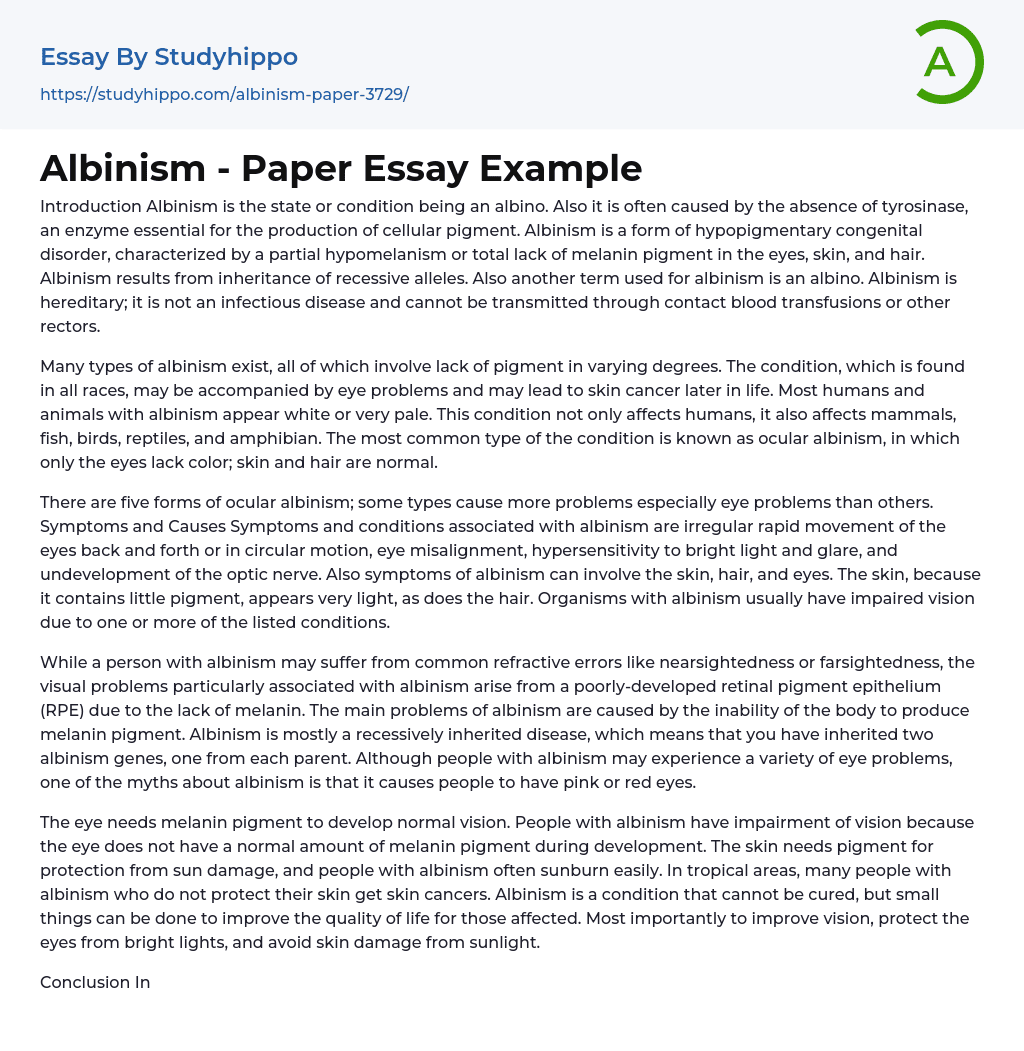Introduction Albinism is the state or condition being an albino. Also it is often caused by the absence of tyrosinase, an enzyme essential for the production of cellular pigment. Albinism is a form of hypopigmentary congenital disorder, characterized by a partial hypomelanism or total lack of melanin pigment in the eyes, skin, and hair. Albinism results from inheritance of recessive alleles. Also another term used for albinism is an albino. Albinism is hereditary; it is not an infectious disease and cannot be transmitted through contact blood transfusions or other rectors.
Many types of albinism exist, all of which involve lack of pigment in varying degrees. The condition, which is found in all races, may be accompanied by eye problems and may lead to skin cancer later in life. Most humans and animals with albinism appear white or very pale. This c
...ondition not only affects humans, it also affects mammals, fish, birds, reptiles, and amphibian. The most common type of the condition is known as ocular albinism, in which only the eyes lack color; skin and hair are normal.
There are five forms of ocular albinism; some types cause more problems especially eye problems than others. Symptoms and Causes Symptoms and conditions associated with albinism are irregular rapid movement of the eyes back and forth or in circular motion, eye misalignment, hypersensitivity to bright light and glare, and undevelopment of the optic nerve. Also symptoms of albinism can involve the skin, hair, and eyes. The skin, because it contains little pigment, appears very light, as does the hair. Organisms with albinism usually have impaired vision due to one or more of the listed conditions.
While a person with albinis
may suffer from common refractive errors like nearsightedness or farsightedness, the visual problems particularly associated with albinism arise from a poorly-developed retinal pigment epithelium (RPE) due to the lack of melanin. The main problems of albinism are caused by the inability of the body to produce melanin pigment. Albinism is mostly a recessively inherited disease, which means that you have inherited two albinism genes, one from each parent. Although people with albinism may experience a variety of eye problems, one of the myths about albinism is that it causes people to have pink or red eyes.
The eye needs melanin pigment to develop normal vision. People with albinism have impairment of vision because the eye does not have a normal amount of melanin pigment during development. The skin needs pigment for protection from sun damage, and people with albinism often sunburn easily. In tropical areas, many people with albinism who do not protect their skin get skin cancers. Albinism is a condition that cannot be cured, but small things can be done to improve the quality of life for those affected. Most importantly to improve vision, protect the eyes from bright lights, and avoid skin damage from sunlight.
Conclusion In conclusion our research paper is about albinism. Our research paper talks about how albinism occurs, the symptoms and causes, and the treatment. It is often caused by the absence of tyrosinase, an enzyme essential for the production of cellular pigment. It is hereditary, not an infectious disease. It cannot be transmitted through sex. The symptoms and causes are when the eyes move irregular back and forth fast. The main problems of albinism are caused by the inability
of the body to produce melanin pigment.
People with albinism have impairment of vision because the eye does not have a normal amount of melanin pigment during development. Albinism is a condition that cannot be cured, but small things can be done to improve the quality of life for those affected. Reference page • http://skin-care. health-cares. net/albinism-causes. php • http://en. wikipedia. org/wiki/Albinism • www. answers. com/topic/albinism • www. healthatoz. com/healthatoz. Atoz/common/standard/transform. jsp? requestURI=/healthatoz/Atoz/ency/albinism:jsp Albinism [pic] Tawanna Sutherland LaKeia Davis Ms. Jenkins 10/31//08 5th period
- Microbiology essays
- Bacteria essays
- Cell essays
- Enzyme essays
- Photosynthesis essays
- Plant essays
- Natural Selection essays
- Protein essays
- Viruses essays
- Cell Membrane essays
- Human essays
- Stem Cell essays
- Breeding essays
- Biotechnology essays
- Cystic Fibrosis essays
- Tree essays
- Seed essays
- Coronavirus essays
- Zika Virus essays
- Pregnancy essays
- Death essays
- Asthma essays
- Chronic Pain essays
- Diabetes essays
- Infection essays
- Infertility essays
- Pain essays
- Sexually Transmitted Disease essays
- Cholesterol essays
- Epidemic essays
- Pathogen essays
- Symptom essays
- Water supply essays
- Myocardial Infarction essays
- Chronic essays
- Hypertension essays
- Black Death essays
- Breast Cancer essays
- Down Syndrome essays
- Apoptosis essays
- Tuskegee Syphilis Experiment essays
- Type 2 Diabetes essays
- Anatomy and Physiology essays
- Addiction essays
- Biodegradation essays
- Dental Care essays
- Disease essays
- Disorders essays
- Health Care essays
- Intelligence Quotient essays




